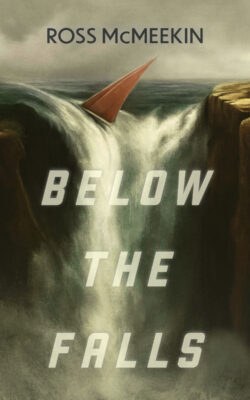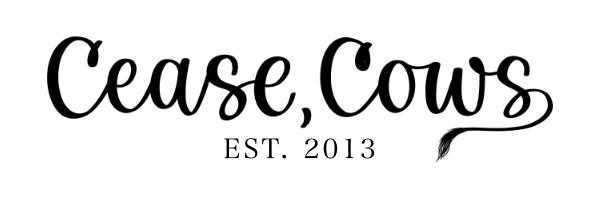Longtime readers may remember “Tusks” by Ross McMeekin, a wonderful piece of microfiction published in 2022. McMeekin’s new collection, Below the Falls, offers a diverse collection of stories about characters navigating their lives with courage, dignity, humor, and so much more. Purchase your copy here.

McMeekin shared his thoughts in a recent interview with Cease, Cows.
Chuck Augello: Describe Below the Falls to potential readers. What should they expect when they pick up the book?
Ross McMeekin: A reader should expect to travel. The first four stories move from the rural Pacific Northwest to New York City to Los Angeles to snowy Midwest farmlands. The stories also travel between characters, from a thirty-something ice climber to a pitcher in the Little League World Series to a mountain hermit to someone whose ears have turned into oranges. Where a strength of many story collections is their unity in terms of place, characters, and/or theme, I believe one of the strengths of this collection is its diversity in terms of those same aspects.
CA: In the title story, a father-and-son fishing trip sets the stage for violence and reflection. Neither character is named. Each is referred to either as “the father” or “the boy.” Why did you choose not to name the characters? Tell us about the essential conflict between the father and the boy.
RM: As a younger writer, I took part in a fiction workshop where a student chose not to name his characters, and one of the participants responded that he should have given his characters the dignity of a name. That stuck with me, and for a while, I was moved by the idea and adopted it as my own. Soon after, I realized the power of addressing characters by something different, like a title that evoked a role or identity that a given name wouldn’t have provided. Though at first the choice was simply intuitive, in reflection I think I chose to name the characters the father and the boy because doing so flirts with the language of parables or myths and asks the reader to understand the story not just as a realist reportage, but as a narrative that reaches more explicitly toward a universal reality.
The essential conflict of both characters, to me, is between loyalty and conscience. I think our identity is often braided in relationships, and those relationships can be patterned tragically. There are many familial narratives that a psychologist or other professional might define one way, while the family members themselves might define it very differently. Both the characters have a particular understanding of their family that results in tragedy, but also, troublingly, connection.
CA: In “Tusks” the unnamed narrator suddenly grows tusks. I won’t reveal the ending, but it’s comic and thought-provoking. How did you come to write that story?
RM: The image of a person growing tusks came first—from where, I don’t know. Next came the voice, which is casual, playful, and almost kidding, which was kind of the mood I was in at the time. From there, the history of the tusk-growing and aftermath kind of spilled out toward the ending, which itself was a delightful surprise to me. I wrote it all in one sitting and revised it a bit, but not much. For me, it’s rare for a piece to come out fully formed, but it’s a treat when it happens.
CA: “Libidonomics” was one of my favorites. It’s a fun, complicated story about two characters, both using each other and both in denial about it. The narrator is creepy but also endearing. Tell us about the story.
RM: I’m glad you found the narrator both creepy and endearing (I do, too). The narrator—a rich, fracking mogul in search of love—took hold of me, like it was a person who wanted not just to tell me something but convince me of something. He anticipates the skepticism of his audience and tries to steer the narrative in such a way that his perspective seems like the right one. Characters who argue for their perspective of their own story can be fascinating because in doing so they reveal so much about themselves—it’s not just their actions but the way they perceive their actions that are on display. There were a few points in the story where I felt the urge to reign him in—the underwater modeling scene based on The Graduate being one—but I decided to just go for it and let him be outrageous, and trust that readers would both understand him and be disgusted by him (and anything in between).
CA: “Tonight We Are Kings” addresses homelessness and addiction. We sense an unnamed trauma in the narrator’s past, but the story remains in the moment, following the man through a single night. What was the genesis of the story? What are some of the challenges in writing about these issues?
RM: Like “Libidonomics” and “Tusks”—and now that I’m thinking about it, a lot of my stories—the story started with an image and a voice and that creative impulse to follow it wherever it might go. I don’t plan out my stories in advance; it’s more of a discovery process. The opening scene is outside of Staples Center in Los Angeles, where I’d been a couple of times with a friend to see Lakers games when I lived there. I’d been reading a lot of Denis Johnson at the time, so I think the voice, and the conversations between the two characters, were inspired by his collection, Jesus’ Son. The subtext of a past trauma that’s only hinted at came later.
I think a challenge I found in writing about this character was to stay as close to his experience as I possibly could. In a story that involves the larger issues you mentioned, the “aboutness” of the story can sometimes interfere with an honest appraisal of one character’s particular experience. The individual character’s story can get swallowed up by a larger cultural narrative, and in it, their own experience can be diminished, or even lost altogether. Instead of trying to write the story of, say, all people who struggle with alcohol abuse, I sought one small story of one particular person who does.
CA: Do you have a favorite story in the collection? If so, what is it, and why?
RM: My favorites change, but right now, I think mine is a flash fiction piece called, “Breakup Sketch,” which first appeared in Maudlin House. It follows a lawyer whose relationship with a budding star comedian comes to a decision point. While it works as a straightforward realist narrative, the subtextual architecture of the story is a sort of puzzle that slowly comes together toward the end. I like different sorts of patterning in stories, particularly that of images, which can create their meaning alongside the dialogue, gesture, and interior musings of the characters.
CA: What are some of the challenges in putting together a collection? Tell us about the book’s journey to publication.
RM: With this collection, which includes stories written over a decade ago alongside ones that were months old, trying to wedge all of them into a neat thematic box or whatever was a task, one that I eventually gave up on. It came together one night when I decided to just go with my intuition, which is the best part of me. I started with the title story, “Below the Falls,” and then, one by one, added what felt like the best story to go next, until I got to the end, leaving a dozen-or-so stories out. I was surprised to find that the collection had a cohesion that I couldn’t have predicted beforehand.
I entered a very short piece of mine, “The Failure,” in a microfiction contest put on by Thirty West Publishing House last winter. I’d been a fan of Thirty West for a while, having picked up wonderful books by Shome Dasgupta, Anna Vangala Jones, and Jules Archer. I was very fortunate that my micro made it to the finals, and afterward, editor Josh Dale sent me an email asking if I had anything he could take a look at. I sent him the collection and the rest is history.
CA: Who are some writers whose work excites you? Do you have a particular favorite story or book?
RM: There are so many! Since I mentioned “Breakup Sketch,” as my current favorite in my collection, I’ll go old school with a story that makes some of the same moves. In Richard Brautigan’s collection Revenge of the Lawn, there’s a flash fiction-length piece called “The Weather in San Francisco” that pops into my mind every so often. It follows an elderly woman who orders an inordinate amount of meat from a butcher. Why she orders so much meat isn’t revealed until the very end, but the reason is hinted at the beginning in a way that likely wouldn’t be noticed until a second read. There’s a story going on below the surface that is built on a culmination of details that seem on first read tertiary to the plot, but by the end, they’ve taken on a meaning much larger than the story seems to hold at first glance. I love stories that work on a lot of different levels, and I’m partial to stories that have a lot of bees, and this has both.
CA: There’s no shortage of ways to spend one’s time. Why do you choose to write fiction?
RM: This is a tough question. At a surface level, it’s simply because I enjoy it so much. A person I follow on social media once wrote something like there is no better high than when the writing is going well. I think that speaks to the joy and elation that can come, in small and large doses, when a story moves toward realization. I think, for me, this happens when I discover what a story is about, or what a character does or thinks next, and why. I think writing fiction is a way to educate myself, with my imagination and intuition as the teachers. And I love to learn.
–
Chuck Augello (Contributing Editor) is the author of The Revolving Heart, a Best Books of 2020 selection by Kirkus Reviews. His work has appeared in One Story, SmokeLong Quarterly, Literary Hub, The Coachella Review, and other fine journals. He publishes The Daily Vonnegut, a website exploring the life and art of Kurt Vonnegut. His novel, A Better Heart, was released in November 2021.

